Overview
The title "10 Essential Features for an Engaging AR App Experience" raises a pivotal inquiry: What are the key characteristics that drive the creation of an engaging augmented reality application? This article delineates critical features, including:
- A user-friendly interface
- Real-time performance
- High-quality graphics
- Object recognition
- Cross-platform compatibility
These elements are not merely beneficial; they are essential for enhancing user interaction and satisfaction within AR environments. By focusing on these characteristics, developers can significantly elevate the user experience, ultimately leading to greater engagement and retention.
Introduction
The rapid evolution of augmented reality (AR) technology has opened up a world of possibilities for developers and users alike. As demand for immersive experiences continues to grow, it becomes crucial to understand the essential features that make an AR app engaging. This article delves into the key elements that not only enhance user interaction but also drive satisfaction and loyalty. However, with a plethora of features available, how can developers prioritize what truly matters to create an unforgettable AR experience?
Magic Playbox: User-Friendly Interface for Enhanced Engagement
A user-friendly interface is paramount for any AR app, as it facilitates seamless navigation through features and content. This includes:
- Clear menus
- Intuitive gestures
- Readily accessible help options
By prioritizing usability, developers can significantly enhance user interaction, allowing individuals to focus on exploring the app rather than grappling with its functionality. For instance, research indicates that employing recognizable icons and designs can substantially reduce the learning curve for newcomers, resulting in greater satisfaction and prolonged engagement.
Successful AR app applications consistently integrate these principles, demonstrating that efficient interface design directly influences engagement levels. As the AR landscape continues to evolve, the emphasis on intuitive navigation will remain critical, ensuring that users can fully immerse themselves in the experience without unnecessary obstacles.
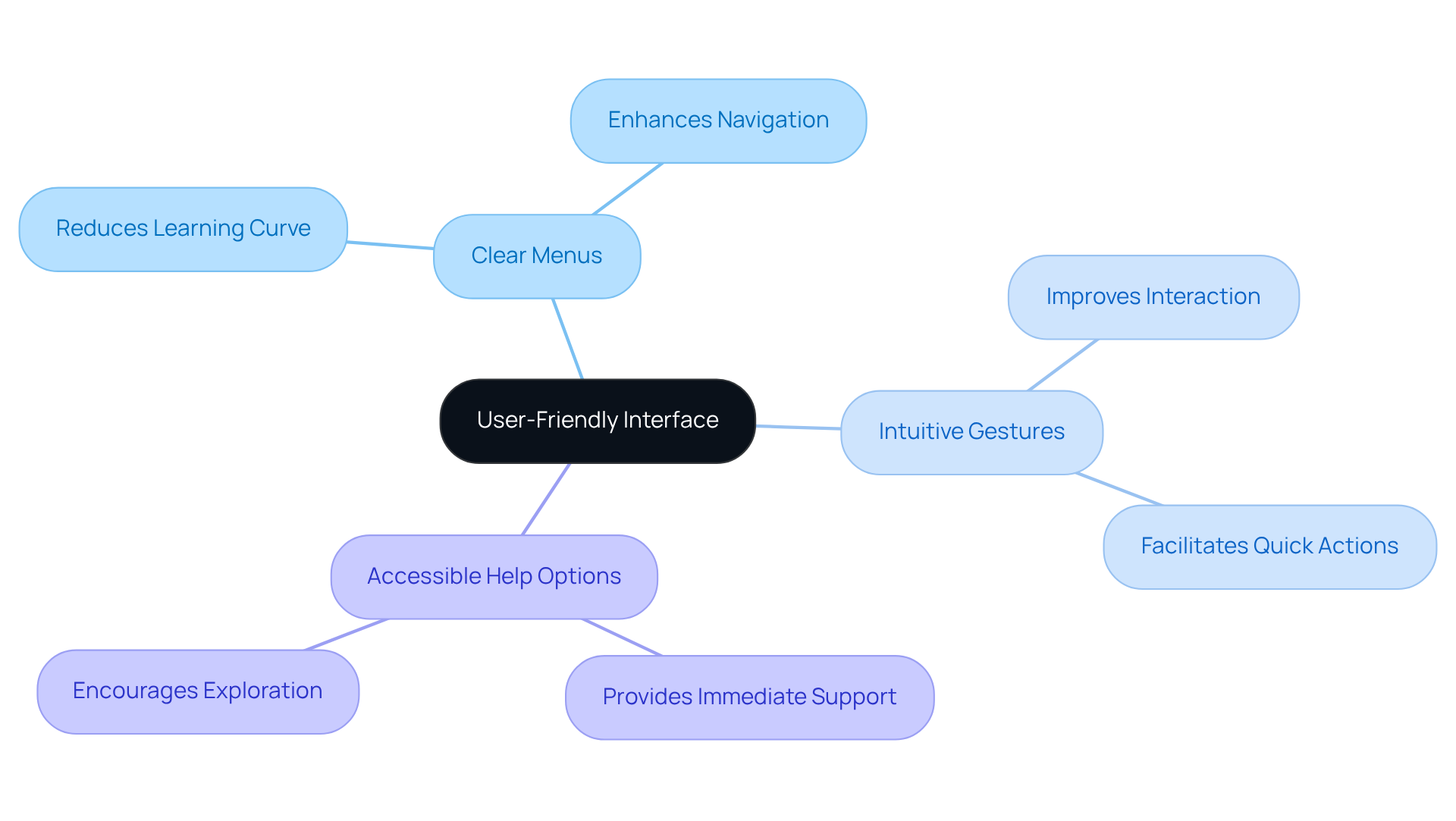
Real-Time Performance: Ensuring Seamless User Experiences
Real-time performance is paramount in augmented reality applications; even minimal lag can disrupt immersion, leading to user frustration. Developers must prioritize optimizing app performance by minimizing load times and ensuring instantaneous interactions.
- Employing efficient coding practices
- Utilizing lightweight assets
- Leveraging advanced hardware capabilities
are essential strategies for achieving this objective. For instance, applications that implement real-time tracking and rendering significantly enhance engagement, allowing users to interact seamlessly with virtual elements integrated into their real-world environment. Notably, AR can boost sales by up to 80% through the integration of augmented reality modules, underscoring the critical need for performance optimization to drive business outcomes.
Furthermore, with the AR and VR market projected to expand from $30 billion in 2022 to over $520 billion by 2031, it is crucial to invest in AR app performance optimization to maintain competitiveness. Additionally, advancements in 5G technology are expected to reduce latency and enhance throughput for AR applications, further emphasizing the necessity for smooth interactions. This level of optimization not only enhances client interactions but also fosters greater customer loyalty and satisfaction.
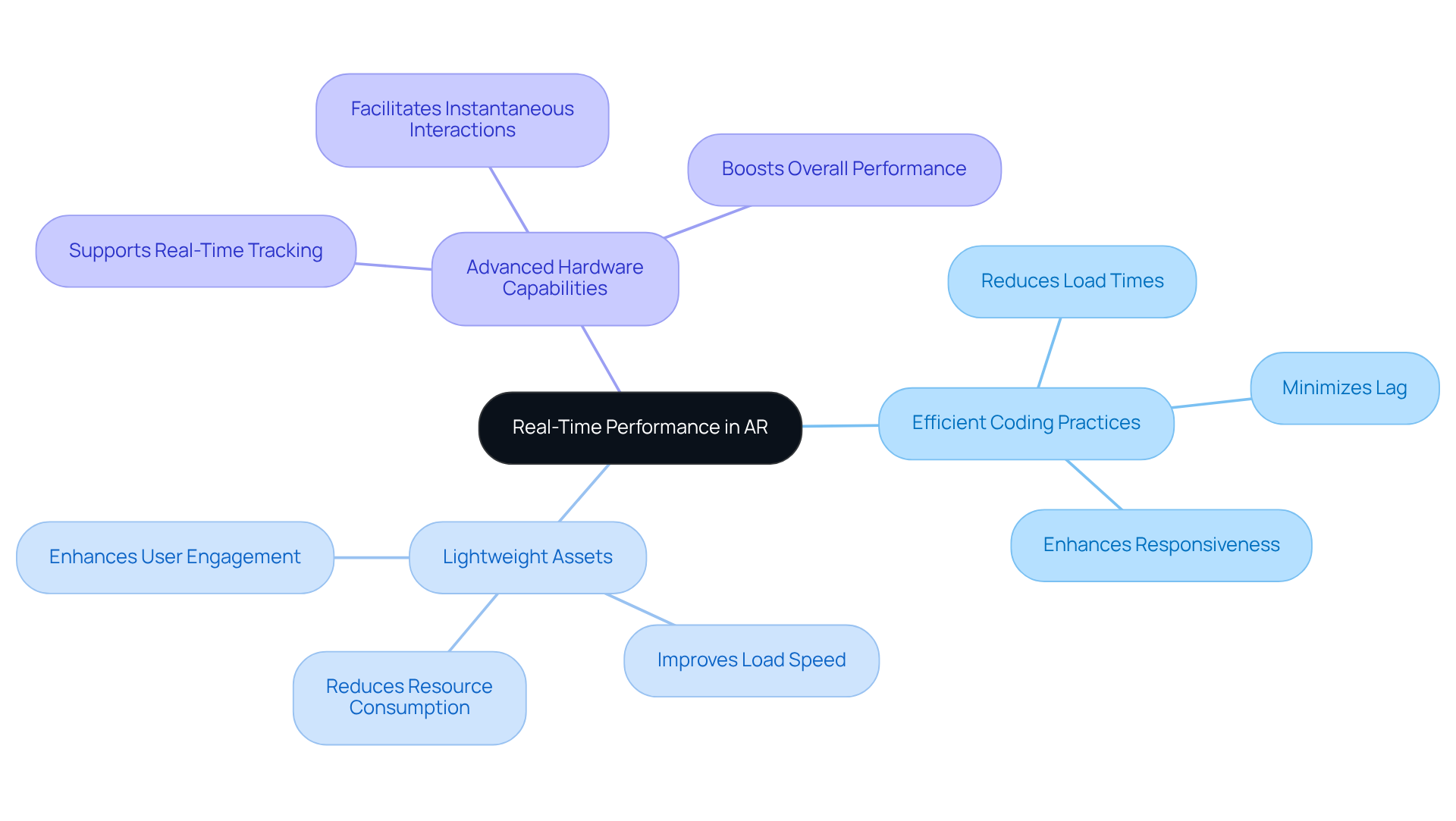
High-Quality Graphics: Captivating Users with Stunning Visuals
High-quality graphics are essential for engaging individuals and enhancing their experience with the AR app. At Magic Playbox, we employ advanced rendering techniques and high-resolution textures to craft visually striking environments that effectively captivate users. For instance, the implementation of realistic lighting and shadows not only bolsters the believability of virtual objects but also promotes seamless integration with the real world. This meticulous attention to detail significantly boosts engagement, with research indicating that immersive visuals can lead to a 15% increase in average session duration.
Furthermore, captivating visuals strengthen the narrative, enhancing overall engagement and memorability. Brands leveraging high-quality graphics through the AR app provided by Magic Playbox have reported substantial increases in engagement and sales, underscoring the transformative power of stunning visuals in AR applications.
Object Recognition: Enabling Interactive Experiences
Object recognition stands as a transformative feature in AR apps, enabling these platforms to identify and interact with real-world objects effectively. This capability fosters dynamic interactions, such as overlaying pertinent information or animations on recognized items, which can enhance engagement by a remarkable 40% when timely context is provided.
For instance, consider an AR app designed for furniture shopping; it could seamlessly identify an individual's existing furniture and recommend complementary items, thereby streamlining the shopping experience.
By harnessing the power of object recognition, developers can create more tailored and captivating experiences that inspire users to delve deeper into the app.
E-commerce brand managers must contemplate the integration of object recognition into their AR app strategies to maximize customer satisfaction and stimulate interaction. This is especially critical as they strive to enhance brand loyalty through innovative solutions, such as those offered by Magic Playbox.
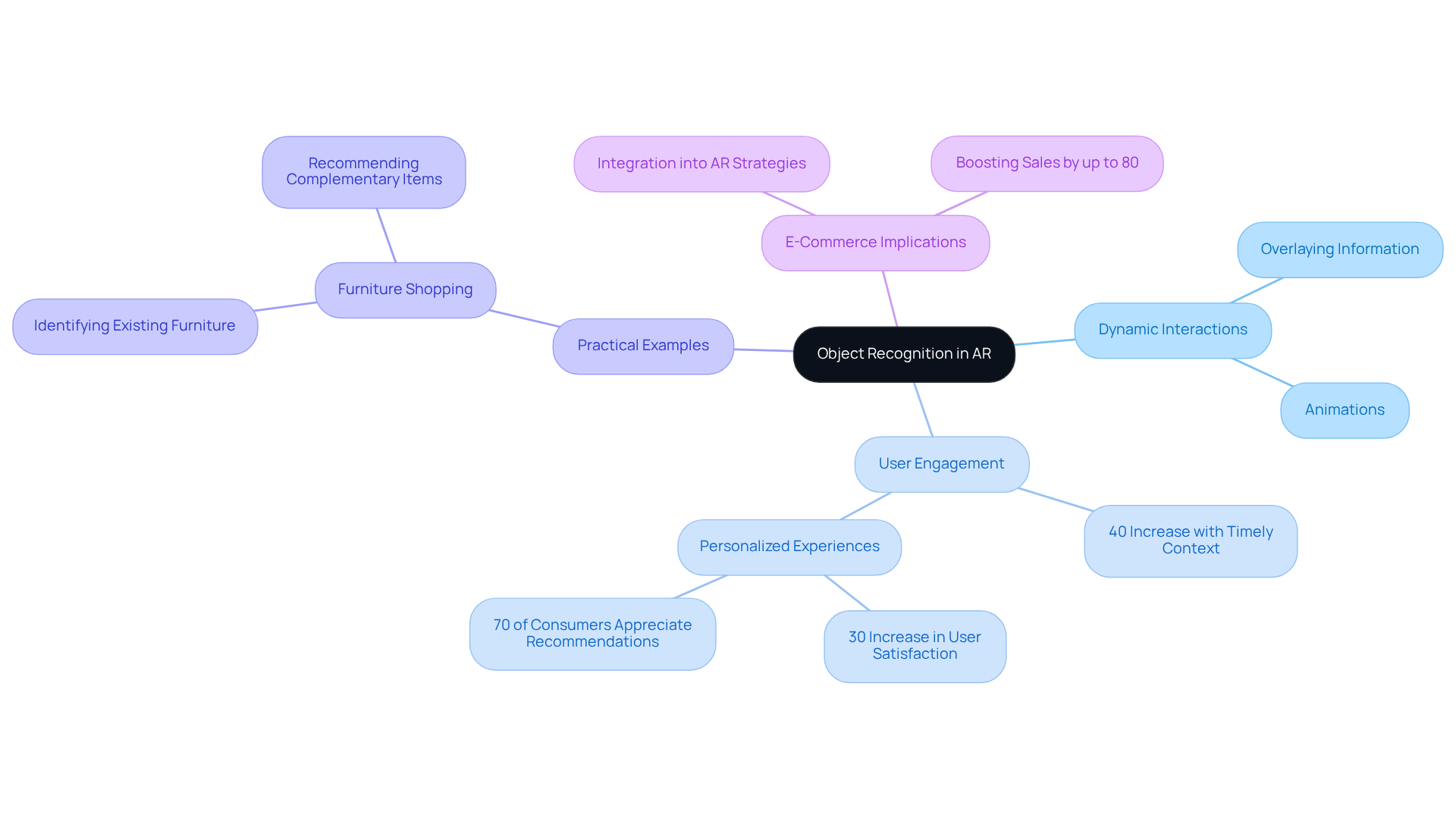
Cross-Platform Compatibility: Expanding User Reach
Cross-platform compatibility is essential for maximizing the reach of the AR app applications. By ensuring seamless functionality across diverse devices and operating systems, developers can significantly broaden their audience. This includes optimizing apps for both iOS and Android platforms, as well as leveraging web-based AR solutions accessible through browsers.
Frameworks such as Unity and ARKit support this cross-platform development, allowing individuals to interact with the AR app on any device. For instance, Magic Playbox has successfully implemented AR solutions that enhance engagement by providing consistent experiences across platforms, ultimately driving customer loyalty and increasing sales.
E-commerce brand managers must prioritize cross-platform strategies by considering consumer preferences and device usage patterns. As the XR industry evolves, the significance of device compatibility will only grow, making it crucial for developers to adopt these strategies to meet audience expectations and expand their market presence.
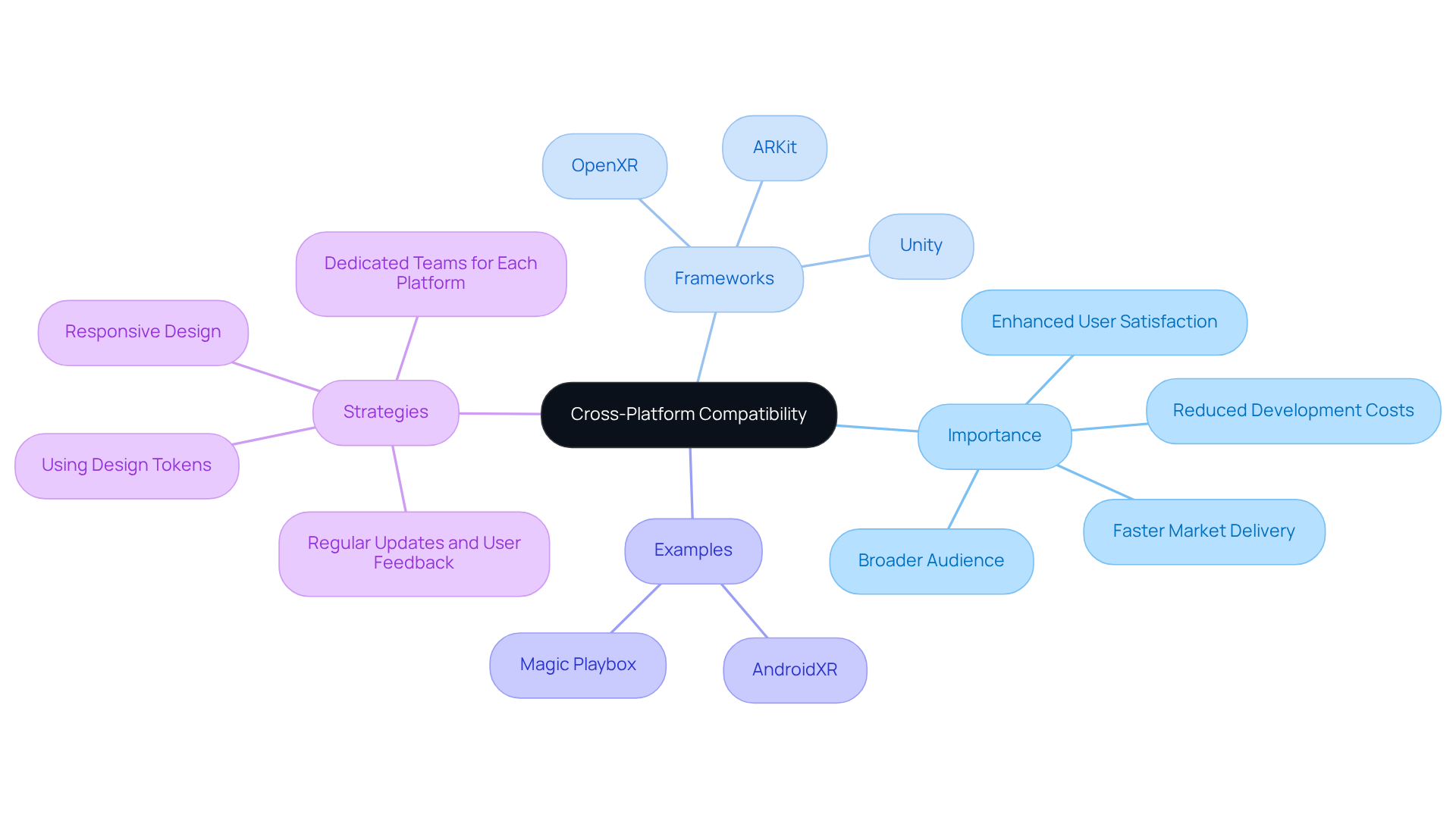
Marker-Based Applications: Triggering Engaging Interactions
Marker-based applications leverage visual markers, such as QR codes or specific images, to activate augmented reality experiences. This approach fosters tangible engagement, allowing individuals to scan markers and unlock exclusive content or features.
For example, a museum app can employ marker-based AR to deliver detailed information about exhibits when users scan specific artworks, thereby enhancing their understanding and appreciation of the pieces. Such interactions not only captivate users but also encourage exploration and interaction with their surroundings, significantly elevating the overall quality of the application.
Research indicates that AR interaction has surged nearly 20% since early 2020, with conversion rates increasing by 90% for consumers engaging with AR compared to those who do not. By harnessing marker-based interactions, developers can create unforgettable experiences that resonate with users, positioning AR as a powerful tool for enhancing customer involvement across various contexts, including museums and retail environments.
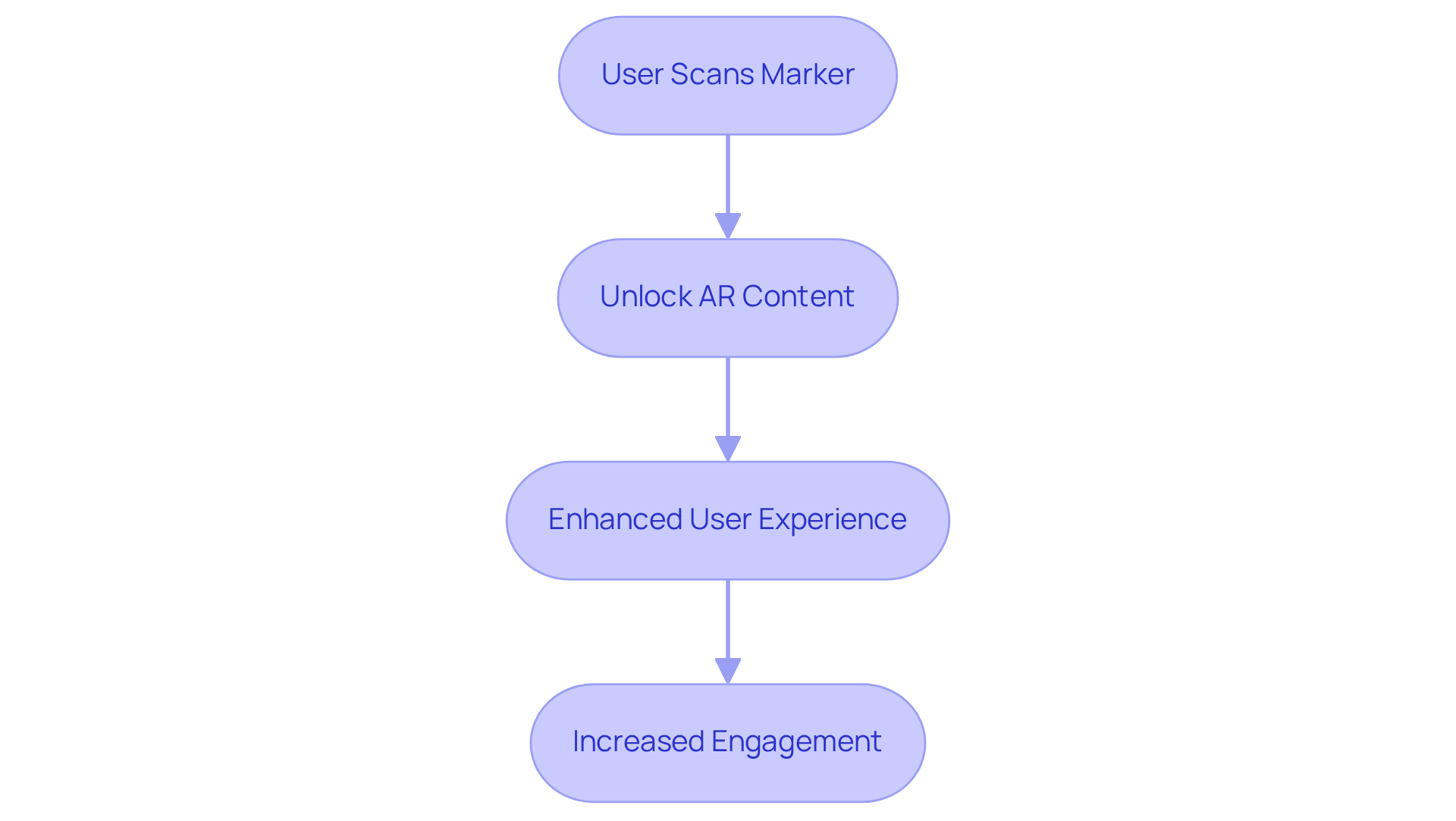
Location-Based Applications: Personalizing User Experiences
Location-based applications leverage geographic data to deliver personalized experiences that resonate deeply with users via an AR app. By tailoring content to an individual's specific location, developers can craft interactions that are not only relevant but also compelling. For instance, an AR app can provide navigation by showcasing nearby attractions or businesses, enriching the exploration experience.
This customized approach significantly boosts engagement; research indicates that AR interaction has surged by nearly 20% since early 2020, with conversion rates soaring by 90% among users engaging with AR. Furthermore, as Ben Houston asserts, "Using AR can give customers the confidence to buy, increase their post-purchase satisfaction, and reduce product return rates." Such personalization fosters a stronger connection between the user and the application, ultimately driving increased repeat usage.
The impact of tailored content in an AR app is profound, enhancing overall engagement and encouraging ongoing interaction. A prime example is the IKEA Place AR app, which effectively employs location-based AR to assist customers in visualizing furniture within their own spaces, thereby reducing product returns and bolstering customer confidence.
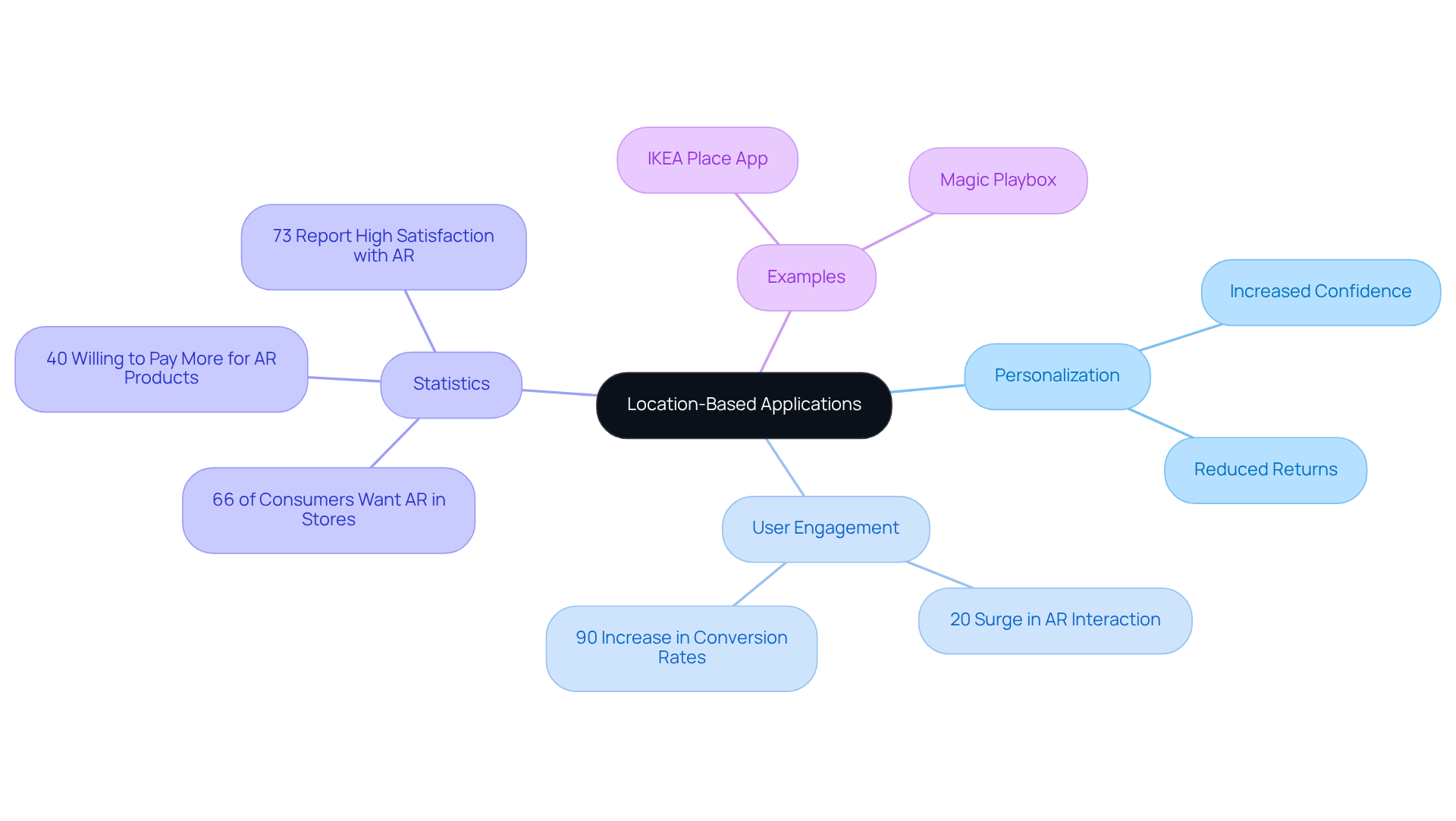
Superimposition AR: Visualizing Products in Real Environments
The AR app for superimposition serves as a transformative tool that allows individuals to visualize products within their real-world environments, fundamentally enhancing the shopping experience. By empowering customers to see how items such as furniture or decor integrate into their spaces, AR plays a pivotal role in shaping purchase decisions.
For instance, the AR app from IKEA allows users to position virtual furniture in their living rooms, leading to more informed choices and driving conversion rates up by as much as 40%. This capability not only boosts engagement—evidenced by the fact that AR product experiences are 200% more captivating than their non-AR counterparts—but also fosters greater confidence in the purchasing process, as 63% of customers assert that AR would improve their shopping experience.
Furthermore, a significant 71% of consumers express a willingness to shop more frequently if they could utilize AR during their shopping endeavors, highlighting the substantial positive impact of AR on shopping behavior. Given these insights, it is clear that incorporating an AR app into retail strategies is not merely beneficial; it is essential for staying competitive in an evolving market.
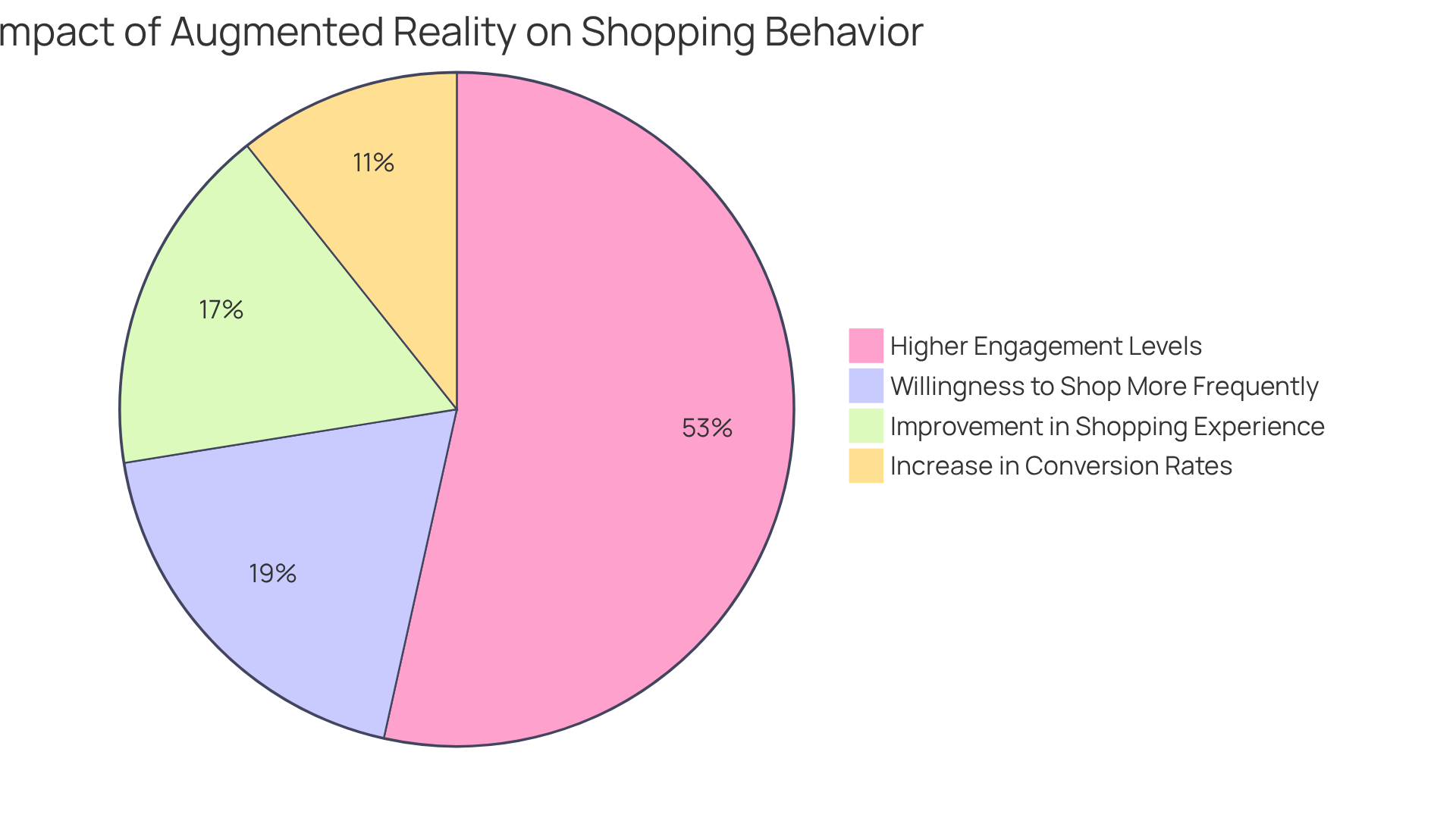
Development Steps: Integrating Essential Features for Engagement
Incorporating vital elements for interaction in the development of the AR app necessitates a strategic method that connects with E-commerce Brand Managers. First, it is essential to identify the target audience and their specific needs, ensuring that the app's features align with expectations. With 72% of luxury fashion consumers in the UK showing an interest in AR for their digital experiences, understanding this demographic is vital for improving brand interaction. Next, selecting the appropriate technology stack is essential to support the desired functionalities. The AR app market is projected to reach $50 billion by 2028, highlighting the growing demand for innovative solutions.
Developers should then concentrate on creating a prototype to test interactions and gather valuable feedback. This step is crucial, as 64% of customers believe that AR boosts brand loyalty, suggesting that consumer satisfaction directly affects involvement. Iterative testing and refinement are essential to guarantee the app provides a seamless and engaging interaction. For instance, companies that implemented AR technology reported a 50% reduction in training time and a 30% increase in productivity, showcasing the effectiveness of user-centered design.
By following these steps, developers can create an AR app that captivates individuals while promoting continuous involvement, ultimately fostering customer loyalty and enhancing the overall shopping journey. Magic Playbox, as a leader in AR solutions, exemplifies how immersive experiences can transform customer interactions in e-commerce.
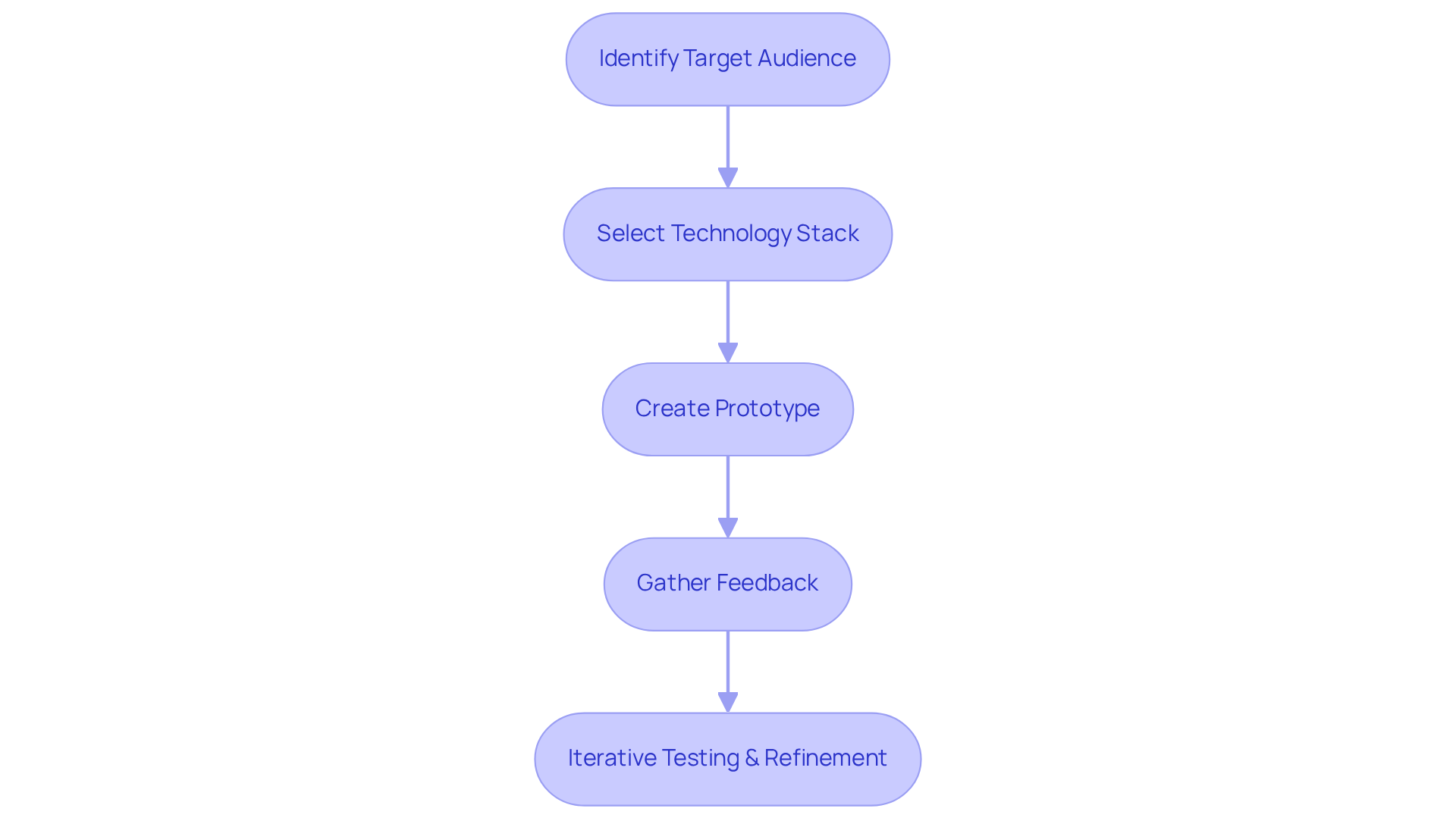
Choosing the Right AR SDK: Leveraging Technology for Engagement
Selecting the appropriate AR SDK is crucial for developing an engaging AR app. Developers must evaluate several factors, including compatibility with target devices, available features, and ease of integration. Prominent SDKs like ARKit, ARCore, and Vuforia offer features that significantly enhance interaction. For instance, ARKit provides robust tracking capabilities and advanced scene understanding, while ARCore excels in environmental awareness and multi-user support. Vuforia distinguishes itself with its image recognition and model target features, making it ideal for applications requiring high interactivity.
The effect of SDK choice on participant engagement cannot be overstated. Research indicates that AR product interactions are 200% more engaging than their non-AR counterparts, highlighting the potential for increased customer interaction. Moreover, brands utilizing AR technologies have reported sales boosts of up to 80% through effective integration of AR modules. By selecting an SDK that aligns with the AR app's goals and audience expectations, developers can leverage these technologies to create captivating interactions that enthrall viewers.
Examples of successful AR applications demonstrate the effectiveness of strategic SDK selection. For instance, IKEA's AR app empowers individuals to visualize how furniture will fit in their homes, which enhances the shopping experience and drives sales. Similarly, AR applications in retail have shown that employing 3D technologies can increase conversion rates by up to 40%, underscoring the importance of selecting the right tools to maximize user engagement.
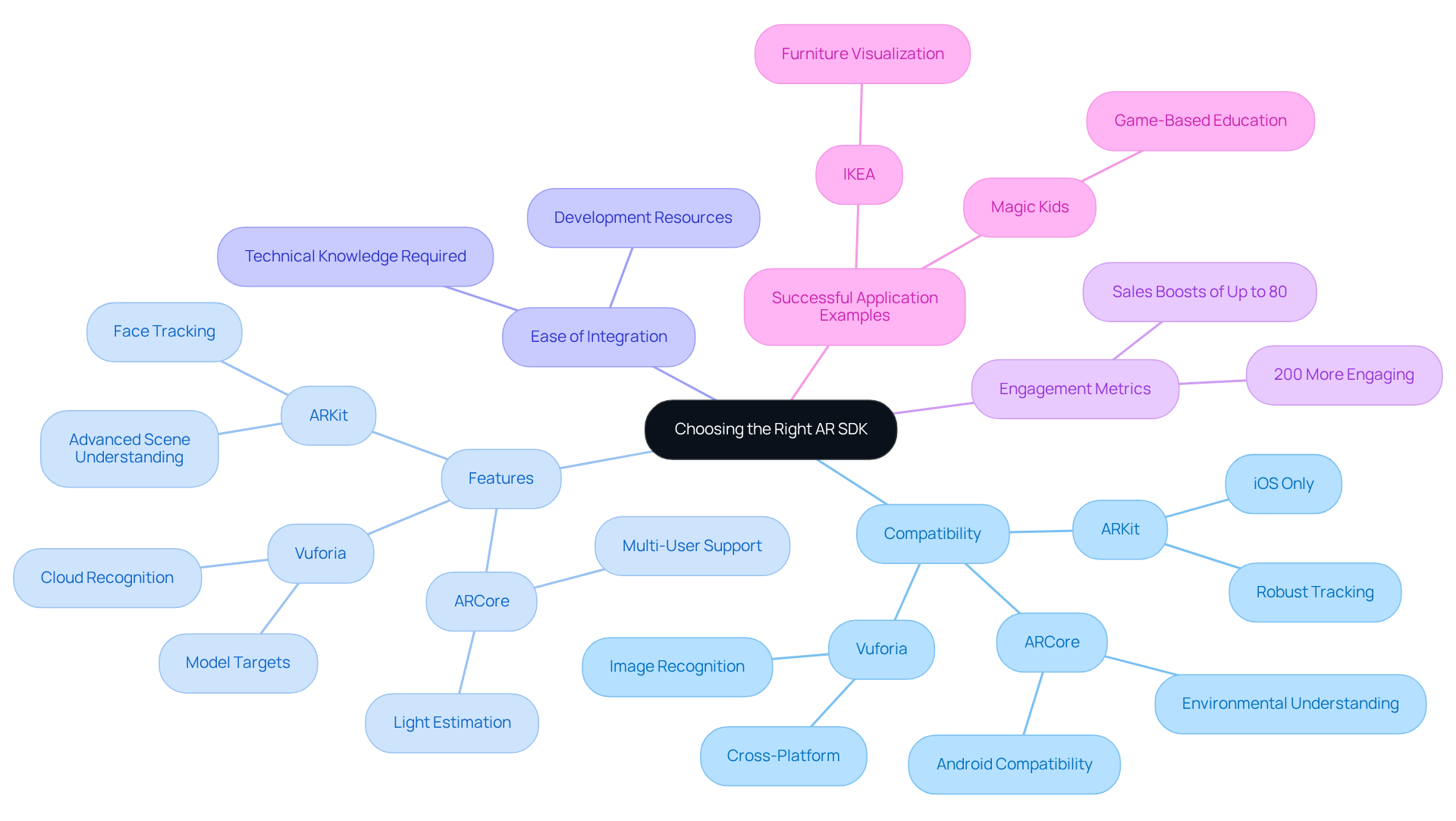
Conclusion
The development of an engaging augmented reality (AR) app is fundamentally anchored in several essential features that significantly enhance user experience and interaction. By prioritizing elements such as:
- A user-friendly interface
- Real-time performance
- High-quality graphics
- Innovative functionalities like object recognition and location-based services
developers can create immersive experiences that captivate users. These features streamline navigation and foster seamless interactions, ensuring that users remain engaged and satisfied throughout their journey within the app.
Key insights from the article underscore the importance of:
- Optimizing performance to minimize lag
- Employing high-resolution visuals to create stunning environments
- Integrating advanced technologies to personalize user experiences
Moreover, the significance of cross-platform compatibility cannot be overstated; it allows apps to reach a broader audience and cater to diverse user preferences. By leveraging marker-based interactions and superimposition techniques, developers can craft memorable experiences that resonate deeply with users, ultimately driving engagement and loyalty.
In a rapidly evolving AR landscape, the call to action for developers and brand managers is unequivocal: prioritize the integration of these essential features to enhance user interaction and maintain competitiveness in the market. As the demand for AR applications continues to surge, embracing these strategies will be crucial for creating compelling experiences that foster customer loyalty and elevate brand engagement. By investing in the right technologies and focusing on user-centered design, the potential for transformative outcomes in the AR space is immense.
Frequently Asked Questions
Why is a user-friendly interface important for AR apps?
A user-friendly interface is crucial for AR apps as it facilitates seamless navigation through features and content, allowing users to focus on exploring the app rather than struggling with its functionality.
What elements contribute to a user-friendly interface in AR applications?
Key elements include clear menus, intuitive gestures, and readily accessible help options. These features help reduce the learning curve for newcomers and enhance overall user satisfaction and engagement.
How does real-time performance affect user experience in AR applications?
Real-time performance is vital in AR applications because even minimal lag can disrupt immersion and lead to user frustration. Optimizing app performance by minimizing load times and ensuring instantaneous interactions is essential for a seamless experience.
What strategies can developers use to optimize performance in AR apps?
Developers can employ efficient coding practices, utilize lightweight assets, and leverage advanced hardware capabilities to enhance performance and minimize lag in AR applications.
What is the potential impact of augmented reality on sales?
Integrating augmented reality modules can boost sales by up to 80%, highlighting the importance of performance optimization in driving business outcomes.
How is the AR and VR market expected to grow in the coming years?
The AR and VR market is projected to expand from $30 billion in 2022 to over $520 billion by 2031, emphasizing the need for investment in AR app performance optimization to maintain competitiveness.
What role do high-quality graphics play in AR applications?
High-quality graphics are essential for engaging users and enhancing their experience. Advanced rendering techniques and high-resolution textures create visually striking environments that captivate users and promote seamless integration with the real world.
How do captivating visuals influence user engagement?
Immersive visuals can lead to a 15% increase in average session duration, strengthen narratives, and enhance overall engagement and memorability, resulting in substantial increases in engagement and sales for brands using AR apps.




